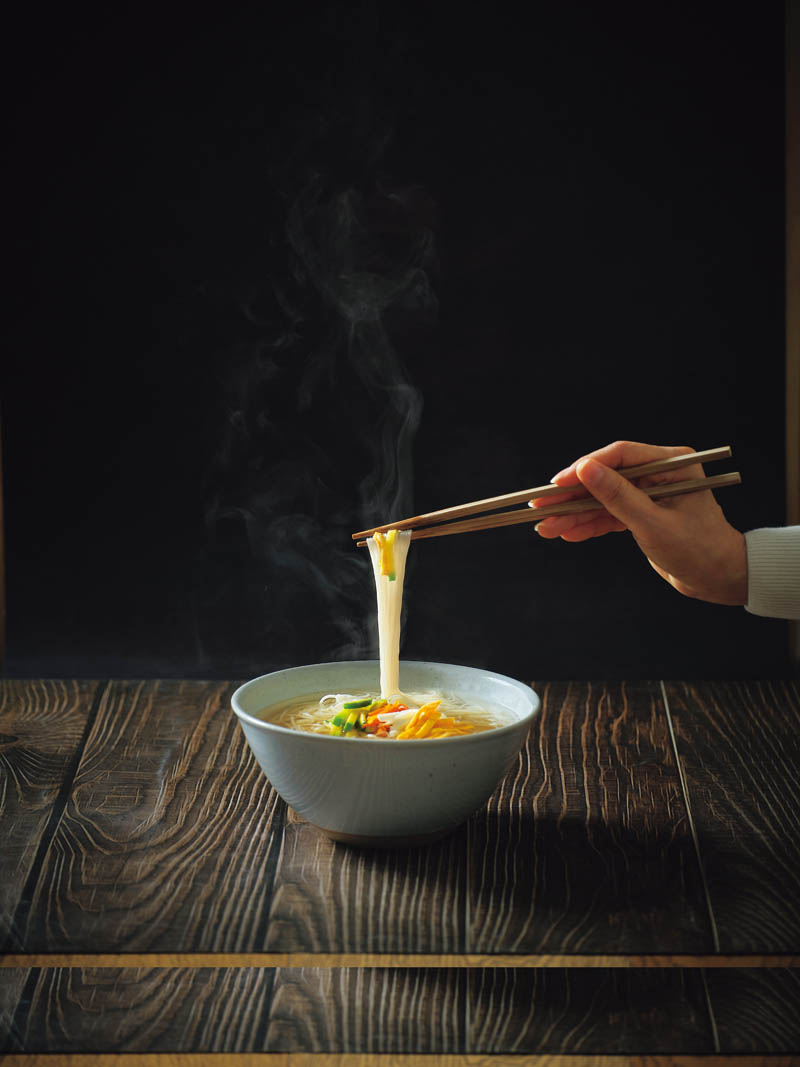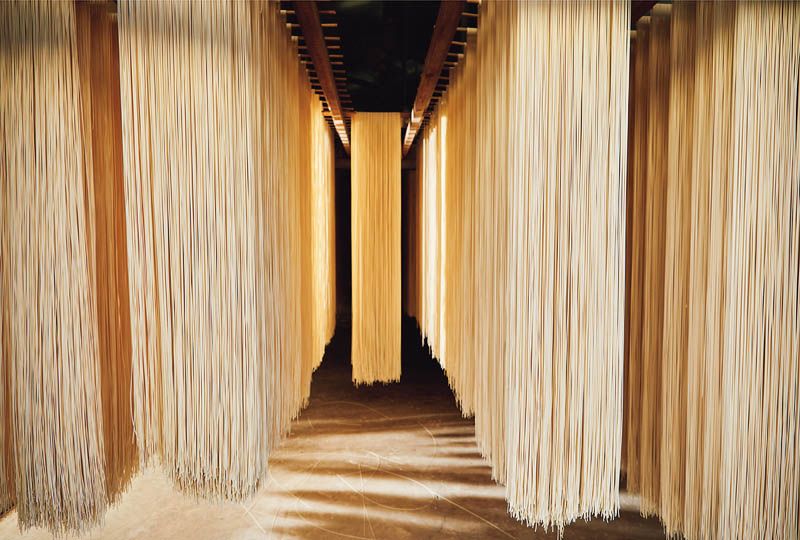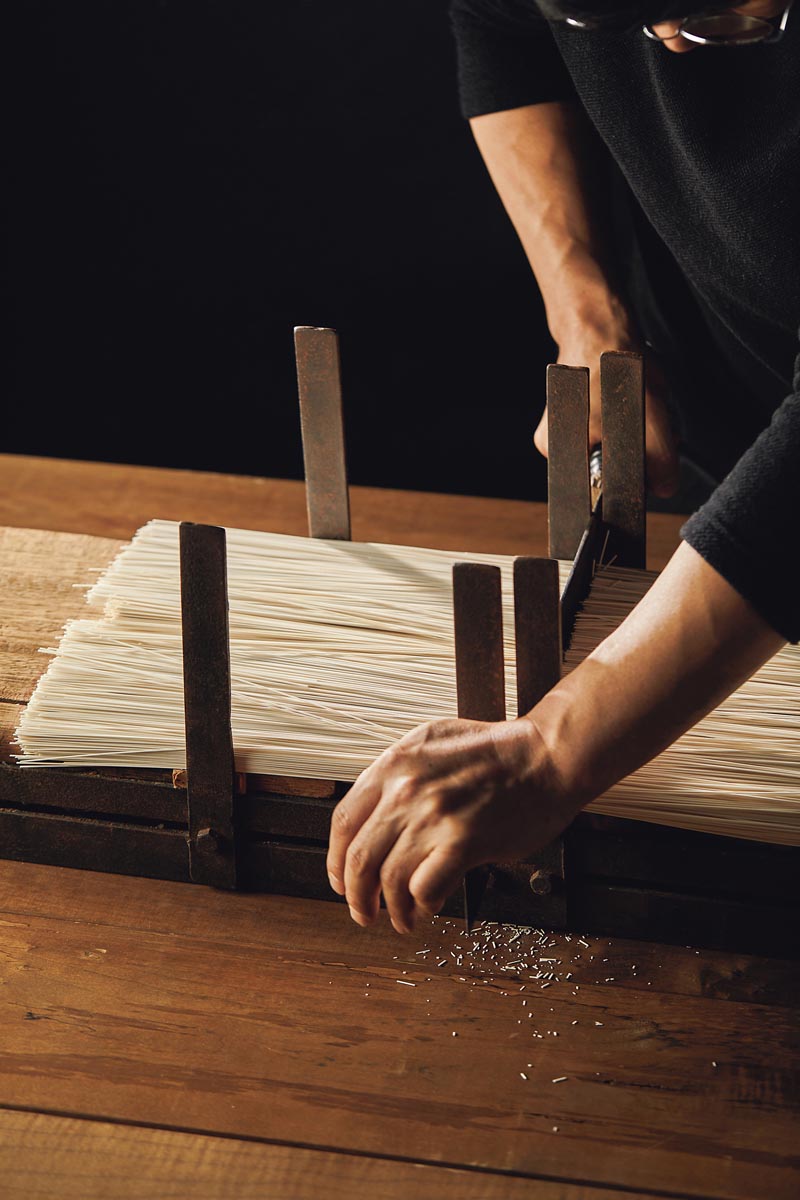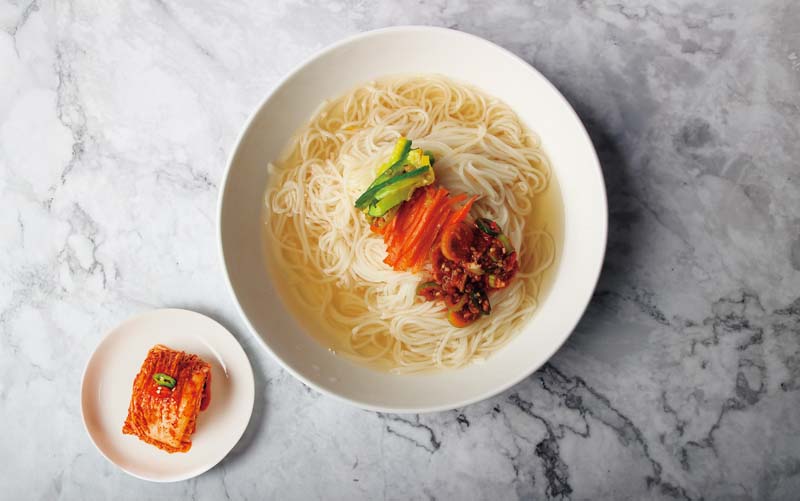Noodles have not always been an integral part of Korean cuisine. Traditionally reserved for grand occasions, they were once prepared as a sign of respect for visiting foreign envoys. The dish known as
janchi guksu, or “banquet noodles,” has long been associated with celebratory gatherings. Despite changes in ingredients and preparation methods over the centuries, janchi guksu continues to carry symbolic meaning.

Janchi guksu is one of Korea’s most representative noodle dishes. It consists of long, thin wheat noodles called somyeon topped with various garnishes and served in a flavorful anchovy broth.
Wheat was once a very precious ingredient in Korea, as the peninsula’s climate was not well-suited for its cultivation. During the Goryeo Dynasty (918–1392), it was imported from China, while records from the Joseon Dynasty (1392–1910) indicate that a small quantity of wheat was cultivated in the peninsula’s cooler, drier northern regions, where it was planted in late autumn and harvested in early summer. In Korea, noodles were primarily made from other ingredients such as finely ground buckwheat, mung beans, and soybeans, making them more brittle and giving them a rougher texture and darker color.
The use of wheat, with its high gluten content, made it possible to produce long, thin noodles with a lighter color and smoother surface. Their clean and refined appearance led people to as-sociate these noodles with purity. While wheat noodles are ubiquitous today, long ago they would have been a remarkable sight to those encountering them for the first time.

Since weather conditions can greatly affect the natural noodle drying process, maintaining the right temperature and humidity throughout is essential. Pictured here are somyeon hung out to dry at AhwaJeonTongGookSU, a popular local brand from Gyeongju.
© AhwaJeonTongGookSU

Kim Yeongcheol, who is at the helm of AhwaJeonTongGookSU, hand-cuts dried somyeon to the perfect length. While the company started using modern noodle-making machines in the late 2010s, over 90 percent of the production process is still done the traditional way by hand.
© AhwaJeonTongGookSU
FOR SPECIAL DAYS
During the Goryeo Dynasty, the Chinese envoy Xu Jing visited Korea and later wrote an account of his travels. In Goryeo dogyeong (Illustrated Account of Goryeo), he remarked, “When envoys enter the capital, they are served over ten types of food, with noodles being the foremost.” Likewise, the Annals of the Joseon Dynasty (Joseon wangjo sillok) record that during Buddhist ceremonies, noodles were served to important guests alongside treats such as yugwa (deep-fried rice puffs), dubutang (tofu soup), and fruit.
During the reign of King Sejo (r. 1455–1468), an order was made to procure noodles from various parts of the country when they were needed to treat visiting Ming Dynasty envoys. However, preparing noodles proved challenging during the reign of King Seonjo (r. 1567–1608), so rice was served to envoys instead.
In ordinary households, noodles were only enjoyed on special occasions such as weddings or milestone birthdays. They were served to all guests at these celebrations to wish long, healthy, and happy lives for the people being honored. The name janchi guksu, literally meaning “banquet noodles,” comes from this tradition. Today, when unmarried young people are asked “When are you going to treat me to some noodles?”, it is a roundabout way of asking when they plan to get married.
NOODLE-MAKING MACHINES
The dictionary definition of janchi guksu is “noodles served in a warm, clear broth with various garnishes.” More specifically, it refers to a dish made by simmering anchovy broth for a long time and adding long, thin wheat noodles called somyeon. Many people wrongly assume the dish has a long history, but the version we know today has only been around for a hundred years.
Traditionally, Korean noodle dishes were not confined to just a few ingredients or types as they are today. While buckwheat flour was most commonly used, vegetables or meat would often be cut into thin shreds and coated with flour to serve as noodles. In some instances, even flower petals were used to make noodles. So, when did somyeon become commonly available?
In the early 19th century, Yi Bingheogak, a female scholar of the late Joseon Dynasty, wrote the Encyclopedia of Women’s Daily Life (Gyuhap chongseo). This compendium includes the term “oemyeon,” which refers to a cold noodle dish eaten in summer consisting of somyeon in a cool infusion of omija, a flavorful red berry native to Korea, northern China, and the Russian Far East. During the late Joseon period, a Silhak scholar named Yi Gyu-gyeong compiled an encyclopedia called Oju yeonmun jangjeon sango, which also describes a method for making oemyeon. The process involved kneading flour with oil and salt, then stretching the dough into long thin strands and drying them, similar to how somyeon is made today. The character oe (倭) refers to Japan, so somyeon was likely introduced to Korea from Japan during the late Joseon period, a theory further supported by a 1930s newspaper article that refers to somyeon as “Japanese noodles.”
Somyeon began to be widely produced and consumed in Korea during the Japanese occupation period (1910–1945). Despite wheat’s high gluten content, making long, thin noodles entirely by hand was no easy task. The advent of production. Newspapers from the 1920s often featured advertisements for the latest noodle-making machines, indicating a strong demand. An article from the Chosun Ilbo published on May 8, 1940, explains how unstable rice supplies gave rise to a social climate that encouraged people to seek alternatives, leading to the increased popularity of somyeon. The article also notes how many savvy merchants shifted from selling rice to the flour and noodle business.
As noodle factories equipped with flour mills and noodle machines began to spring up across the country, mechanized noodle production grew more widespread. Founded in Daegu in 1933 as one of Korea’s first food manufacturing companies, Poongkukmyeon, still in operation today, is the longest-standing noodle factory in the country. Five years after it began operating, a trading company opened in the same city and began selling locally-grown groceries, dried fish, and noodles. Under the brand name Byeolpyo Noodles, somyeon became one of its signature products, and the trading company grew into Korea’s largest conglomerate, Samsung.
Janchi guksu originated in the years following the Korean War (1950–1953), a time when many people displaced by the conflict settled in Busan, a thriving anchovy fishing hub, and Korea began receiving large amounts of food aid from the United States in the form of surplus wheat. With an ample supply of wheat flour, people began making noodles and serving them in anchovy broth, giving rise to the dish we know today.
NOODLE SOUP FOR THE SOUL
reserved for special occasions. At home it serves as a quick and simple meal, and for office workers and students it’s a budget-friendly option, easily found at snack bars and food stalls. However, at wedding banquets, it has been overshadowed by the popularity of Western-style buffets, nowadays relegated to little more than a formality.
Despite this, few Koreans would turn down a bowl of janchi guksu — with silky somyeon thoroughly rinsed in cold water and placed in a carefully prepared anchovy broth. Though it may no longer carry the prestige it once did, for many it remains a dish that has brought them comfort at some point in their lives. Served in a bowl brimming with steaming broth, its deep anchovy aroma evoking the scent of the sea, and delicate noodles coiled at the center, janchi guksu conjures up images of the vast blue ocean, bringing warmth and solace to anyone who eats it.

Although janchi guksu is now a popular everyday dish, it was once a delicacy reserved for special occasions such as weddings and milestone birthday celebrations, as reflected in its name, which means “banquet noodles.”
© Shutterstock